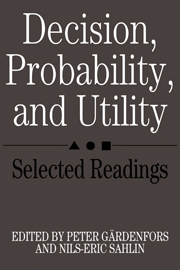Book contents
- Frontmatter
- Contents
- List of contributors
- Preface
- 1 Introduction: Bayesian decision theory – foundations and problems
- Part I Foundations of Bayesian decision theory
- Part II Conceptualization of probability and utility
- Part III Questionable rules of rationality
- Part IV Unreliable probabilities
- Part V Causal decision theory
- 17 Counterfactuals and two kinds of expected utility
- 18 Causal decision theory
- 19 Ratifiability and stability
- References
- Name index
- Subject index
18 - Causal decision theory
Published online by Cambridge University Press: 05 June 2012
- Frontmatter
- Contents
- List of contributors
- Preface
- 1 Introduction: Bayesian decision theory – foundations and problems
- Part I Foundations of Bayesian decision theory
- Part II Conceptualization of probability and utility
- Part III Questionable rules of rationality
- Part IV Unreliable probabilities
- Part V Causal decision theory
- 17 Counterfactuals and two kinds of expected utility
- 18 Causal decision theory
- 19 Ratifiability and stability
- References
- Name index
- Subject index
Summary
Introduction
Decision theory in its best-known form (as presented, for instance, in Jeffrey, 1965) manages to steer clear of the thought that what's best to do is what the agent believes will most tend to cause good results. Causal relations and the like go unmentioned. The theory is simple, elegant, powerful, and conceptually economical. Unfortunately it is not quite right. In a class of somewhat peculiar cases, called Newcomb problems, this noncausal decision theory gives the wrong answer. It commends an irrational policy of managing the news so as to get good news about matters which you have no control over.
I am one of those who have concluded that we need an improved decision theory, more sensitive to causal distinctions. Noncausal decision theory will do when the causal relations are right for it, as they very often are, but even then the full story is causal. Several versions of causal decision theory are on the market in the works of Gibbard and Harper (1978, Chapter 17, this volume), Skyrms (1980), and Sobel (1978), and I shall put forward a version of my own. But also I shall suggest that we causal decision theorists share one common idea, and differ mainly on matters of emphasis and formulation. The situation is not the chaos of disparate approaches that it may seem.
Of course there are many philosophers who understand the issues very well, and yet disagree with me about which choice in a Newcomb problem is rational.
- Type
- Chapter
- Information
- Decision, Probability and UtilitySelected Readings, pp. 377 - 405Publisher: Cambridge University PressPrint publication year: 1988
- 1
- Cited by



